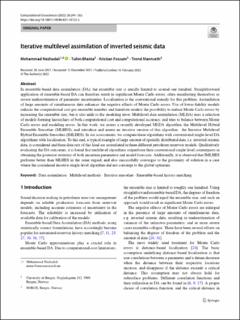| dc.contributor.author | Nezhadali, Mohammad | |
| dc.contributor.author | Bhakta, Tuhin | |
| dc.contributor.author | Fossum, Kristian | |
| dc.contributor.author | Mannseth, Trond | |
| dc.date.accessioned | 2022-07-13T07:55:12Z | |
| dc.date.available | 2022-07-13T07:55:12Z | |
| dc.date.created | 2022-05-04T17:22:09Z | |
| dc.date.issued | 2022 | |
| dc.identifier.citation | Computational Geosciences. 2022, 26 241-262. | en_US |
| dc.identifier.issn | 1420-0597 | |
| dc.identifier.uri | https://hdl.handle.net/11250/3004984 | |
| dc.description.abstract | In ensemble-based data assimilation (DA), the ensemble size is usually limited to around one hundred. Straightforward application of ensemble-based DA can therefore result in significant Monte Carlo errors, often manifesting themselves as severe underestimation of parameter uncertainties. Localization is the conventional remedy for this problem. Assimilation of large amounts of simultaneous data enhances the negative effects of Monte Carlo errors. Use of lower-fidelity models reduces the computational cost per ensemble member and therefore renders the possibility to reduce Monte Carlo errors by increasing the ensemble size, but it also adds to the modeling error. Multilevel data assimilation (MLDA) uses a selection of models forming hierarchies of both computational cost and computational accuracy, and tries to balance between Monte Carlo errors and modeling errors. In this work, we assess a recently developed MLDA algorithm, the Multilevel Hybrid Ensemble Smoother (MLHES), and introduce and assess an iterative version of this algorithm, the Iterative Multilevel Hybrid Ensemble Smoother (IMLHES). In our assessments, we compare these algorithms with conventional single-level DA algorithms with localization. To this end, a typical example of large amount of spatially distributed data, i.e. inverted seismic data, is considered and three data sets of this kind are assimilated in three different petroleum reservoir models. Qualitatively evaluating the DA outcomes, it is found that multilevel algorithms outperform their conventional single-level counterparts in obtaining the posterior statistics of both uncertain parameters and model forecasts. Additionally, it is observed that IMLHES performs better than MLHES in the same regard, and also successfully converges to the proximity of solution in a case where the considered iterative single-level algorithm did not converge to the global optimum. | en_US |
| dc.language.iso | eng | en_US |
| dc.rights | Navngivelse 4.0 Internasjonal | * |
| dc.rights | © The Author(s) 2022 | |
| dc.rights.uri | http://creativecommons.org/licenses/by/4.0/deed.no | * |
| dc.title | Iterative multilevel assimilation of inverted seismic data | en_US |
| dc.title.alternative | Iterative multilevel assimilation of inverted seismic data | en_US |
| dc.type | Peer reviewed | en_US |
| dc.type | Journal article | en_US |
| dc.description.version | publishedVersion | en_US |
| cristin.ispublished | true | |
| cristin.fulltext | original | |
| cristin.qualitycode | 1 | |
| dc.identifier.doi | 10.1007/s10596-021-10125-3 | |
| dc.identifier.cristin | 2021552 | |
| dc.source.journal | Computational Geosciences | en_US |
| dc.source.volume | 26 | en_US |
| dc.source.pagenumber | 241-262 | en_US |
| dc.relation.project | Norges forskningsråd: 295002 | en_US |

